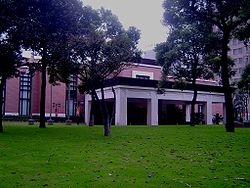
Shanghai Communiqué
Encyclopedia

United States
The United States of America is a federal constitutional republic comprising fifty states and a federal district...
and the People's Republic of China
People's Republic of China
China , officially the People's Republic of China , is the most populous country in the world, with over 1.3 billion citizens. Located in East Asia, the country covers approximately 9.6 million square kilometres...
on February 27, 1972 during President Richard Nixon
Richard Nixon
Richard Milhous Nixon was the 37th President of the United States, serving from 1969 to 1974. The only president to resign the office, Nixon had previously served as a US representative and senator from California and as the 36th Vice President of the United States from 1953 to 1961 under...
's visit to China. The document pledged that it was in the interest of all nations for the United States and China to work towards the normalization of their relations, although this would not occur until the Joint Communiqué on the Establishment of Diplomatic Relations
Joint Communiqué on the Establishment of Diplomatic Relations
The Joint Communiqué on the Establishment of Diplomatic Relations of January 1, 1979, established official relations between the United States and the People's Republic of China....
seven years later.
The US and China also agreed that neither they nor any other power should "seek hegemony
Hegemony
Hegemony is an indirect form of imperial dominance in which the hegemon rules sub-ordinate states by the implied means of power rather than direct military force. In Ancient Greece , hegemony denoted the politico–military dominance of a city-state over other city-states...
in the Asia-Pacific region". This was of particular importance to China, who shared a militarized border with the Soviet Union
Soviet Union
The Soviet Union , officially the Union of Soviet Socialist Republics , was a constitutionally socialist state that existed in Eurasia between 1922 and 1991....
.
Regarding the political status of Taiwan
Political status of Taiwan
The controversy regarding the political status of Taiwan hinges on whether Taiwan, Penghu, Kinmen, and Matsu should remain effectively independent as territory of the Republic of China , become unified with the territories now governed by the People's Republic of China , or formally declare...
, in the communiqué the United States acknowledged the One-China policy
One-China policy
The One-China policy refers to the policy or view that there is only one state called "China", despite the existence of two governments that claim to be "China"....
(but did not endorse the PRC's version of the policy) and agreed to cut back military installations on Taiwan
Taiwan
Taiwan , also known, especially in the past, as Formosa , is the largest island of the same-named island group of East Asia in the western Pacific Ocean and located off the southeastern coast of mainland China. The island forms over 99% of the current territory of the Republic of China following...
. This "constructive ambiguity
Constructive ambiguity
Constructive ambiguity is a term generally credited to Henry Kissinger, said to be the foremost exponent of the negotiating tactic it designates. It refers to the deliberate use of ambiguous language on a sensitive issue in order to advance some political purpose. Constructive ambiguity is often...
" (in the phrase of US Secretary of State Henry Kissinger
Henry Kissinger
Heinz Alfred "Henry" Kissinger is a German-born American academic, political scientist, diplomat, and businessman. He is a recipient of the Nobel Peace Prize. He served as National Security Advisor and later concurrently as Secretary of State in the administrations of Presidents Richard Nixon and...
, who oversaw the American side of the negotiations) would continue to hinder efforts for complete normalization.
The communiqué included wishes to expand the economic and cultural contacts between the two nations, although no concrete steps were mentioned.
External links
- http://www.taiwandocuments.org/communique01.htm

